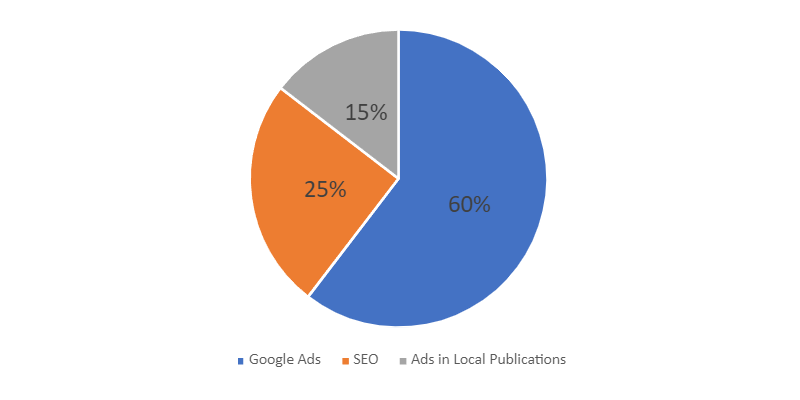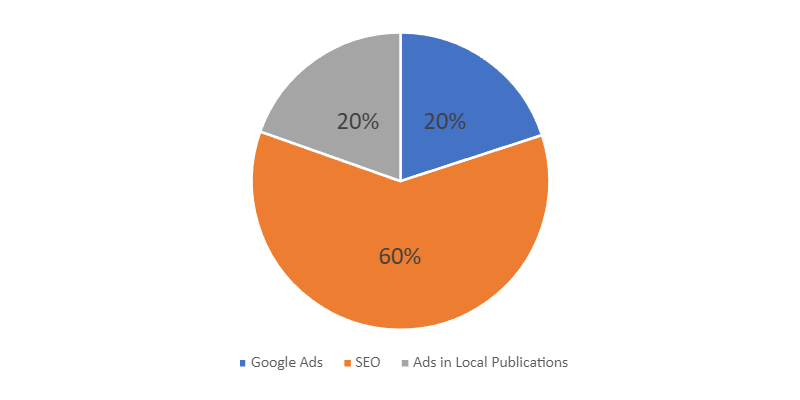How to Market Your Roofing Business

Whether you’re just starting out or an already established name, growing your roofing business is the key to survival. Particularly during a cost-of-living crisis that is expected to last until the latter half of 2023, which will affect consumer spending for years to come.
That’s why it's all the more important to make yourself stand out from your peers, by making use of ALL the tools available to you. This includes maximising your online presence, working with social media and 3rd party sites to generate leads and potentially altering your sales pitch to build better relationships with your customers.
Contents:
- Top Marketing Tips for Roofers
- How Much Should I Spend on Marketing?
- Selling Your Expertise
- Retaining Your Customers
Top Marketing Tips for Roofers
First and foremost, you need to get more eyes on your business. With 60% of consumers looking to spend cautiously going forward, the competition for customers is only going to get fiercer. Below are some of what we consider vital areas to cover to stay competitive.
Accreditations, Certifications & Memberships
One of the first key indicators of trade quality is membership in the NFRC. As the UK’s largest roofing trade association, memberships provide immediate reassurance to customers. Better yet, it also makes your business far more visible, as you will be added to their directory and given your own unique profile page.
Similarly, relevant accreditations offer a stamp of approval for your work, putting customers' minds at ease without the need for you to convince them. The NFRC Component Person Scheme is a prime example which, as a premier accreditation, tells everyone looking at your business that all your work meets with building regulations. It’s important to keep in mind that these accreditations can expire, however, and will need to be kept up to date.
Other Certifications & Accreditations to add to your arsenal include
3rd Party Marketing
A first port of call for most roofers, plumbers, electricians and other trades. 3rd party sites like trustatrader or checkatrade do most of the heavy lifting for you. Not only will they help generate leads, but many will allow customers to message you directly from their sites. This simple process of streamlining communication is a big factor for many when deciding between roofers.
There are a couple of things to be aware of, however, to improve your ROI on these sites:
Profile Pages
These pages will often be the first direct interaction between your roofing business and potential customers. As such it’s important to make them easily scannable, present information in a clear and easily digestible way and, most importantly, make use of high-quality images of your work. Try to get as much of a range as possible of different materials, roof types and jobs to increase engagement.
Branding is another key aspect of these pages. Businesses with clear messaging and well-prepared logos immediately seem more established. Think of your branding as the hook that will keep customers on your page long enough for your photos and bio to persuade them to get in touch.
Reviews

Good reviews are essential to success on 3rd party sites and will typically be the deciding factor for new customers. This is why it's so important to, first of all, build good relationships with your current customers and, second of all, take the time to ask for reviews when the job is done and both parties are happy.
This doesn’t just mean working to ensure that the job goes ahead smoothly, but also dealing with any problems efficiently and with good communication. Delays can sometimes be unavoidable, and it is always better to be prompt and truthful if you do experience issues. Better yet, provide a solution in the same message and you’ll go a long way to earning back your customer’s trust. It’s simple, but good reviews can be just as much about how well you handled difficulties as they are about a job well done.
Social Media
Setting up social media is part and parcel of building your business’s online profile. Whether it’s Facebook, Twitter, Instagram, TikTok or some combination of all of them, making yourself visible is the key part of the equation here. As is engagement. This means posting unique content frequently (on a schedule would be ideal) whilst avoiding low-effort posts that risk being flagged as spam.
These platforms also provide a great opportunity to interact with and learn more about your customer’s needs. In addition to your phone and email, it opens up another channel of communication that some may prefer. Other than potential customers, you can also link up with groups that may help to advertise and sell your services.
Website & SEO
The best way to present yourselves online is by having your very own corner of the internet. A website that tells your customers who you are, what you do and gives your business its credibility. Chances are many of your competitors will have websites of their own. To make sure you’re not outpaced, take the time to research them and discover what you should (or should not as the case may be) do to make yours work. This may be a certain layout, the formatting of a page or the use of pop-ups.
Don’t forget though, it’s not only how your website looks but how well it ranks in search engines. To improve this, we need to dip our toes into the world of SEO. These following principles are just some of the practices you can employ to climb to Google's first page.
Match Content with Intent
Consider what each page of your website is trying to achieve and what exactly you want to rank for. ‘Roofers in ____ area’ for example would be far more likely to rank with a bio or about us page than a blog. Whereas general questions about roofing i.e. how much it costs to replace a roof would be the opposite.
Tailor your content to suit the needs of the customers who are most likely to land on that type of page. Doing so will help foster a sort of trust between your brand and consumers, meaning that even if they don’t end up hiring you in the moment, they may come to you first when their roof does need work.
Make Sure Your Site is HTTPS
Considering it has been a factor in google ranking since 2004, it’s integral that you make sure your site is HTTPS. This not only ensures that the pages on your website are secure by encrypting any information sent from your users to the server but also increases consumer confidence in your roofing business. fortunately, it's now common practice for hosting services to have the necessary SSL package included.
Analyse Site Speed
“53% of mobile sites are abandoned when the sites loads longer than 3 seconds” - Hobo-web
A slow website is the first thing that will send customers elsewhere. Google wants to make their users' experience as pleasant as possible and therefore prioritises sites that load quickly. Google’s page insights tools will provide you with a score out of 100 for you to easily measure this as well as offer a list of improvements. If you find that you don’t have the time or expertise to carry out these fixies, it may be worth considering consulting a web developer for help.

Place Your Targeted Keywords Strategically
When we say targeted keywords, we simply mean the words or phrases you want your pages to rank for when they are searched in google. This could be a particular type of area, job or material you specialise in. When placing these words on your website, they should be put in 3 key locations.
1) Title Tag – This is a HTML element within your page that defines its title and will be seen by both users and search engines. It’s important not to simply stuff your keyword into the tag but use it to describe the page. If it doesn’t fit, you can use keywords that are related to your primary keyword instead. Just remember to keep it easily digestible for your reader.
2) Page Heading – When building your page, you should format the first heading as a H1 (a HTML heading tag that should only be used once at the top of your page) to make it easier for Google to differentiate between the main heading and sub-headings. It’s this man heading which should have your keywords in it.
3) URL – It’s best practice for the words in your URL to match those on the page. Naturally, this means you should also put your keyword in your URL.
Internal Links
Linking to other pages on your site doesn’t just make it easier to navigate but can also help google understand what that page is about. If you have just launched a new page, linking to it from an already established one grants an instant boost in authority and makes it more likely to rank higher.
Optimise Images
When uploading images to your site, consider two things. First their size. All images should be compressed so that they load quickly and don’t slow down your site. As we mentioned above slow sites are far more likely to be penalised by search engines.
Secondly, you’ll want to carefully consider how you use image ALT tags and file names. Describing what is in the image with both of these will help google to understand it better and, in doing so, will improve its ranking.
Meta Descriptions
Similar to the above, meta descriptions help search engines understand the different pages on your website. These small summaries should be both descriptive and compelling making sure to keep them unique whilst using your keywords. Keep the customers intent in mind with the page whilst writing as this will help you to make your text more comprehensive.
IMPORTANT!
Too many references to a specific keyword can be penalised. Keyword stuffing, as it's called is when you shoehorn in your keywords to try and rank higher. It’s a tactic search engine’s can easily spot and can prevent you from hitting the top search results. For the same reason, you should also avoid duplicating your title tags.
Keep Content Unique & Useful
Whether you are writing a company introduction, blog or FAQ it’s key that you keep your content on point. This means keeping focus on the question posed, making it unique and, most importantly, easy for readers of all levels. Keep sentences brief. Don’t use unnecessarily complicated language and don’t get bogged down with irrelevant details. More than the length of your writing what matters most is that it answers all the questions your customers may have.
Google Ads
One big potential revenue generator, especially for those just starting out are google ads. You’ve more than likely seen them yourself at the very top of the first page on google. This helps bring additional traffic in addition to the organic visits you’ll be getting as your business begins to grow.
Of course, you’ll have to pay for these ads, but the good news is that you can estimate their impact without spending a penny simply by creating a google ads account and making use of their keyword research tool. It’s simple to use, intuitive and can give you an accurate idea of how many of your potential customers are searching for specific jobs or materials in your area.
With this information, you can then develop your ads around more niche keywords that, beyond being cheaper, will also be less competitive. Targeting the term ‘roofing’ for example would make your ads appear for any number of searches including ‘roofing sheets’ or ‘roofing ideas’ both terms may not generate the leads you are looking for. Phrases like ‘residential roofing contractor’ on the other hand, being more specific, will most likely only be searched by those looking for a service as opposed to a product.
Once you’ve landed on the handful of keywords you want to focus on, take some time to research your competitors' ads. Dissect what makes them successful, and what headlines they are using to convert and then try to make yours even more engaging. The best way to do this is by homing in on your USPs. It may be price, availability or expertise in a given material – whatever it is make sure to put it front and centre so you can stand out.
Tailor Your Ads to Your Customers Locations
Even if you cover a larger area, say a whole county, there is still no reason you can’t tailor your ads to specific locations to appear in more searches. Google’s location insertion tool has been designed for just that. This will take whatever ad you put up, detect the searchers location and put that in the ad for you.
There is one setting in particular you want to be aware of here. In ‘advanced location options’ you'll find a checkbox that asks whether you want to target people ‘in or regularly in your target location’ or people ‘searching for your target location.’ The latter is the default option but will result in your ads appearing for people who simply search the town or city name as opposed to those who live there. Seeing you’ll likely be looking to speak to homeowners and landlords, we suggest switching it to the former.
Maximise Your Use of Extensions
Google, as the behemoth that they are, don’t simply offer a way to get your adverts out to the exact people you want to see them, they also offer a number of different add-ons to make your ads more compelling. These search ad assets included integrating your phone number, maps, images, pricing and more. For roofers, this means you can tell potential customers immediately where you're based, how to get in touch, a little bit about yourself and provide an example of your work – all in one place.
Just some of the extensions we recommend using are:
- Call
- Location
- Image
- Structures Snippet
- Callout Extensions
Bidding on Competitor Keywords
Google makes it very clear that bidding on your competitors' keywords, even brand names is completely valid and does not go against their code of conduct. When doing this, however, take care to only target keywords from competitors that offer a like-for-like service in the same area.
Word of Mouth
No matter how well your advertisements do or how many five-star reviews you can generate, ultimately people are far more likely to trust friends and family over strangers. Word of Mouth marketing capitalises on just that. Building a reputation organically which encourages your customers to talk about your business without any prompting.
Naturally, providing a quality service is essential for this to work but so is understanding and connecting with your customers. Finding ways to go the extra mile and exceed expectations, providing recommendations, tips and ways to save money – all things that will help them to remember you the next time someone they know needs work done on their roof.
This doesn’t just apply to when you’re on the job either. Right from first contact to sending the invoice you need to make the process as easy as possible for your customers. If you have your own website, that means making the UX (user experience) as seamless as possible. Including contact forums that give users plenty of space to explain their exact needs and an expectation of when they can receive a callback.
Ultimately, you want your customers to be loyal and the only way to do that is by making calling you an easy decision. Be reliable, responsive, kind and courteous but most of all, set realistic expectations and make sure that you meet them.
Referrals
In the same realm of thought as the above, referrals are word-of-mouth marketing with a slight push on your part. Encouraging your customers to share their positive experiences using an incentive (a discount on future work etc.). Think of it like a Facebook ad. You incur a small cost initially, but once customers' eyes are on your business word will start to spread more organically. Done right, referrals can take a business from strength to strength.
That is the theory anyway, but in practice, it never quite works out as well as the theory suggests. In truth, even if your work is superb, if there is nothing unique about you or your business to separate you from your competitors, even happy customers are less likely to bring you up in conversation.
To solve this problem, what you need is a story. Something that, whilst not necessarily reflected in your services, gives your customers something to latch onto. Perhaps yours is a family business or maybe you’ve jumped into this trade after being the victim of a bad roofing experience in the past? Whatever your story is, make sure it is personal and unique. Selling your business in this way won’t just make you more memorable, but will humanize you as well, making customers far more likely to want to be on your team and share in your successes.
How Much Should I Spend on Marketing?
The hard truth of it is, you won’t get far without investing a budget into your marketing. Whether that budget is big or small depends on your current size, though it’s important that it is kept in line with your goals.
- How many leads do you need?
- How many people do you need to reach to secure those leads?
- How much do you want to spend converting these leads into paying customers?
Keep these questions in mind as you set your spends for each area and track their performance regularly so that you can adjust, scale up (if you are looking to grow) or scale back (if you get too busy) as the case may be.
If you are just starting out Google ads are likely where you want to put most of your focus as these will be the quickest and most reliable converters. SEO takes time, though can be more sustainable in the long term. This means whilst you may not prioritise it at the start, as your business grows so should your spend on SEO.
Let’s say you are starting with a budget of £1000 per month, you may find the below split an ideal place to begin.

However, as time goes on and your budget increases you may find that you can reduce your reliance on Google ads to something like this.
Ultimately, your success will come down to regular testing, experimentation and analyse. Through this, you’ll discover what your customers are like, what engages them and the best platform to invest in to turn your leads into revenue. At a certain point, you may even decide to outsource some, if not all of your marketing, to dedicated roofing marketing companies to free up your time to focus on growing other aspects of your business. Again, just remember to always keep those 3 questions in mind as you go through their reports.
Selling Your Experience
Once you’ve got the call, you now need to follow through on all of the promises that you’ve made in your campaigns. Doing so starts with one simple step, find out what they need from you. A simple thing to do on the surface of things, but worth a little bit more probing on your part.
For many, roofs will not be their area of expertise, so do not expect 100% clarity from your customers. Instead, win their trust but asking them about their concerns and any problems they might have in addition to what they are asking you to do. Make it a conversation by keeping these questions open-ended and you’ll more easily be able to figure out their exact budget, timescale and material preferences. All things that can help in going above and beyond expectations.
During this call and when quoting, you’ll want to lean heavily on your technical experience. Even if customers may not necessarily understand everything, it's important to demonstrate your knowledge and skills as well as your expertise with relevant materials.
It’s also worth taking the time to clearly explain your process, including any inspections that may need to be undertaken initially. By going into this detail, you may find that your customer’s actual needs differ or that they need more work done that they may not initially have thought of. This provides an opportunity to recommend suitable products that, again, will demonstrate your expertise.
Following Up
Once you’ve sent over your quote take care not to forget about it and move on. Most roofing jobs are sizeable commitments and decisions. As with any big decision, it can take time and can be slowed down by distractions and other delays. A brief follow-up email or friendly call to see if your customer needs any more information is a great way to keep your business fresh in their mind.
Retaining Your Customers
If a customer is happy with the job you’ve done, chances are you will be the first person they call the next time they need something done. Value these loyal customers. It’s all too easy to delay a smaller job from a previous customer in favour of a higher value one by someone new but it’s this repeat business that can be a lifesaver in tough times – especially as retaining these customers often costs nothing more than a bit of courtesy.
Remember what we said about word-of-mouth marketing. It can be a powerful tool to grow your business, but it can just as easily be its downfall. Customers, particularly loyal ones, are just as happy (if not more so) to share negative experiences as positive ones. Forget this and you run the risk of an avalanche of bad reviews down the line.
If you take anything from this article, it should be this. Regardless of the strategies you choose to test and use, it’s impossible to succeed without a strong foundation. That means being professional, reliable and prepared. Show that you care about your customers and they, in turn, will help your roofing business to grow.

